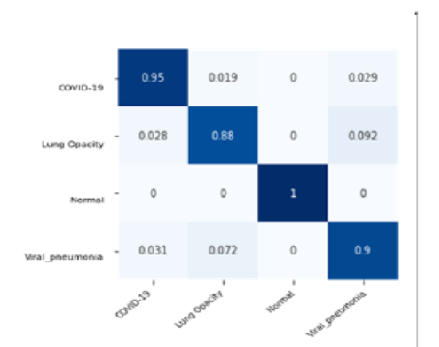


Indian Journal of Science and Technology
Year: 2024, Volume: 17, Issue: 8, Pages: 702-712
Original Article
Mamta Patel1*, Mehul Shah2
1Research Scholar, Instrumentation and Control Engineering, Gujarat Technological University, Gujarat, India
2Associate Professor, Instrumentation and Control Engineering, Vishwakarma Government Engineering College, Gujarat, India
*Corresponding Author
Email: [email protected]
Received Date:13 December 2023, Accepted Date:22 January 2024, Published Date:14 February 2024
Objectives: This study aims to develop a robust medical recognition system using deep learning for the identification of various lung diseases, including COVID-19, pneumonia, lung opacity, and normal states, from chest X-ray images. The focus is on implementing ensemble fixed features learning methods to enhance diagnostic capabilities, contributing to the development of a cost-effective and reliable diagnostic tool for combating the global epidemic of lung disorders. Methods: The study utilizes a Kaggle dataset containing COVID-19 chest radiography images. Raw X-ray images undergo preprocessing for contrast enhancement and noise removal while addressing dataset imbalance through near-miss resampling. Ensemble learning techniques, including two and three-level methods, are employed to harness the strengths of individual base learners—VGG16, InceptionV3, and MobileNetV2. The model's performance is evaluated using metrics such as accuracy, recall, precision, and F1-score. For remote access, a user interface and a shared web link are developed using Python Gradio. Findings: In two-level ensembles, features from base learners are concatenated and classified using a support vector machine. Three-level ensembles use concatenated features classified by three machine learning classifiers, employing a majority voting system for the final prediction. The two-level method achieved 93% accuracy, precision, recall, and F1 score. The three-level ensemble model demonstrates superior performance, achieving 94% accuracy in detecting four lung diseases, namely COVID-19, pneumonia, lung opacity, and normal states. Novelty: This research contributes to the field by showcasing the efficacy of deep learning technology, particularly ensemble learning, in enhancing the detection of lung diseases from raw chest X-ray images. The model employs three modified and efficient pretrained networks for automatic feature extraction, eliminating the need for manual feature engineering. The developed model stands as a promising decision-support tool for healthcare professionals, particularly in low-resource environments.
Keywords: Convolutional Neural Network (CNN), Deep Learning (DL), Transfer Learning (TL), Ensemble learning (EL), Fixed feature extraction, Chest Xrays (CXR), Lung diseases
© 2024 Patel & Shah. This is an open-access article distributed under the terms of the Creative Commons Attribution License, which permits unrestricted use, distribution, and reproduction in any medium, provided the original author and source are credited. Published By Indian Society for Education and Environment (iSee)
Subscribe now for latest articles and news.